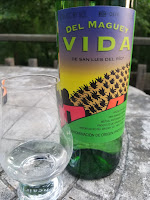 The Vida is crafted as an entry-level Mezcal with "an ABV profile called for by bartenders around the world". It is traditionally handcrafted from 100% mature agave Espadín by the family of Paciano Cruz Nolasco in the village of San Luis Del Rio. The Nolascos are also responsible for the Crema de Mezcal, San Luis Del Rio, Madrecuixe, and Tobaziche labels. The Vida Mezcal starts with vicious smoke on aroma which may be why bartenders favor it as an ingredient. The smoke stretches like the palm fiber covers through the flavor profile. The base is a smooth and creamy sweet agave core laced with tropical fruit. The smooth tail lasts with zero burn and elevating the smoked agave.
The Vida is crafted as an entry-level Mezcal with "an ABV profile called for by bartenders around the world". It is traditionally handcrafted from 100% mature agave Espadín by the family of Paciano Cruz Nolasco in the village of San Luis Del Rio. The Nolascos are also responsible for the Crema de Mezcal, San Luis Del Rio, Madrecuixe, and Tobaziche labels. The Vida Mezcal starts with vicious smoke on aroma which may be why bartenders favor it as an ingredient. The smoke stretches like the palm fiber covers through the flavor profile. The base is a smooth and creamy sweet agave core laced with tropical fruit. The smooth tail lasts with zero burn and elevating the smoked agave. The first cocktail I tried with it is a version of the Mezcal Mule using our reliable Appalachian Brewing Company Ginger Beer. The ginger and smoke dance together as the bite from the ginger beer elevates the mezcal. An alternative is to add Grapefruit juice to provide more tang and to lengthen consumption. Check back for more cocktail recipes. Cheers.
Mezcal Mule
Ginger Beer
Del Maguey Vida
Lime juice
Del Maguey Vida Production Notes:
Village: San Luis Del Rio
Palenquero: Paciano Cruz Nolasco, Marcos Cruz Mendez
State: Oaxaca
Region: Valles Centrales
Maguey: Espadin
Agave Species: A. angustifolia haw
Age of Maguey: 7-8 years
Elevation: 2952 feet (900 meters)
Roast Duration: 3-8 days
Type of Wood: Mezquite, Quebrachi, Huamuchil, Pitayo,
Pochotle, Tepeguaje, Copal Tepomaco, Pino, Encino
Milling: Molino, Electric
Size of Tinas: 1400 L
Fermentation Duration: 8-10 days
Water Source: Rio Hormiga Colorada
Still Type: Copper
Still Size: 350 L
ABV of Mezcal: 42%
Liquid Profile: Vida is distilled to be more widely available with an ABV profile called for by bartenders around the world.









